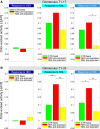Morphofunctional experience-dependent plasticity in the honeybee brain
- PMID: 29142057
- PMCID: PMC5688957
- DOI: 10.1101/lm.046243.117
Morphofunctional experience-dependent plasticity in the honeybee brain
Abstract
Repeated or prolonged exposure to an odorant without any positive or negative reinforcement produces experience-dependent plasticity, which results in habituation and latent inhibition. In the honeybee (Apis mellifera), it has been demonstrated that, even if the absolute neural representation of an odor in the primary olfactory center, the antennal lobe (AL), is not changed by repeated presentations, its relative representation with respect to unfamiliar stimuli is modified. In particular, the representation of a stimulus composed of a 50:50 mixture of a familiar and a novel odorant becomes more similar to that of the novel stimulus after repeated stimulus preexposure. In a calcium-imaging study, we found that the same functional effect develops following prolonged odor exposure. By analyzing the brains of the animals subjected to this procedure, we found that such functional changes are accompanied by morphological changes in the AL (i.e., a decrease in volume in specific glomeruli). The AL glomeruli that exhibited structural plasticity also modified their functional responses to the three stimuli (familiar odor, novel odor, binary mixture). We suggest a model in which rebalancing inhibition within the AL glomeruli may be sufficient to elicit structural and functional correlates of experience-dependent plasticity.
© 2017 Andrione et al.; Published by Cold Spring Harbor Laboratory Press.
Figures





References
-
- Arenas A, Giurfa M, Sandoz JC, Hourcade B, Devaud JM, Farina WM. 2012. Early olfactory experience induces structural changes in the primary olfactory center of an insect brain. Eur J Neurosci 35: 682–690. - PubMed
-
- Brown SM, Napper RM, Mercer AR. 2004. Foraging experience, glomerulus volume, and synapse number: a stereological study of the honey bee antennal lobe. J Neurobiol 60: 40–50. - PubMed
-
- Chakroborty NK, Menzel R, Schubert M. 2016. Environment specific modulation of odorant representations in the honeybee brain. Eur J Neurosci 44: 3080–3093. - PubMed
-
- Chandra SBC, Wright GA, Smith BH. 2010. Latent inhibition in the honey bee, Apis mellifera: is it a unitary phenomenon? Anim Cogn 13: 805–815. - PubMed
Publication types
MeSH terms
Substances
LinkOut - more resources
Full Text Sources
Other Literature Sources
